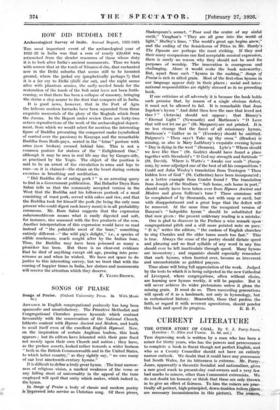HOW DID BUDDHA DIE ?.
Archaeological Survey of India. Annual Report, 1922-1923.
THE most important event of the archaeological year of 1922-28 in India was that a sum of nearly £20,000 was retrenched from the slender resources of those whose duty it is to look after India's ancient monuments. Thus we learn with sorrow that at the tomb of Nizamu-d-din, that enchanted acre in the Delhi suburbs that seems still to be haunted ground, where the jackal cry (prophetically perhaps ?) that it is a far cry to Delhi (Dilli dur ast), and the night seems alive with phantom armies, the sadly needed funds for the restoration of the tomb of the Sufi saint have not been forth- coming, so that there has been a collapse of masonry, bringing the shrine a step nearer to the dust that conquers all in India.
It is good news, however, that in the Fort of Agra the hideous modern barracks have been separated from those exquisite memorials of the glory of the Moghuls which front the Jumna. In the Report under review there are forty-two octavo reproductions of the work of the archaeological depart- ment, from which we would select for mention the interesting figure of Buddha presenting the conquered snake (symbolical of control over the passions) to Kasyapa and the remarkable Buddha from Bodh-gaya, seated in the " lotus " posture with arms (now broken) crossed behind him. This is not a common posture for statues of the " Enlightened One," although it may be seen in real life any day by Ganges-side, as practised by the Yogis. The object of the position is said to be an arrest of the circulation in arms and legs to ease—so it is claimed—the strain on the heart during certain exercises in breathing and meditatiOn.
" Did Buddha die of eating pork ? " is an arresting query to find in a Government publication. Rai Bahadur Daya Ram Sahni tells us that the commonly accepted version in the West that the Buddha and his followers partook of a meal consisting of roast pork, served with cakes and rice, and that the Buddha took for himself the pork (he being the only man present who could digest such heavy meat) is in all probability erroneous. Mr. Ram Sahni suggests that the expression sukaramaddavam means what is easily digested and soft, for instance, rice seasoned with the five products of the cow. Another interpretation of this expression would have us read instead of " the palatable meat of the boar," something entirely different—" the wild pig's delight," i.e., a species of edible mushroom, much sought after by the Indian boar. Thus, the Buddha may have been poisoned as many a picnicker has been. But there is no clear-cut evidence that he died of anything except old age, passing into pare- nirvana as and when he wished. We have not space to do justice to this interesting survey, but we trust that with the coming of happier times in India, her shrines and monuments will receive the attention which they deserve.
F. YEATS-BROWN.






















































 Previous page
Previous page